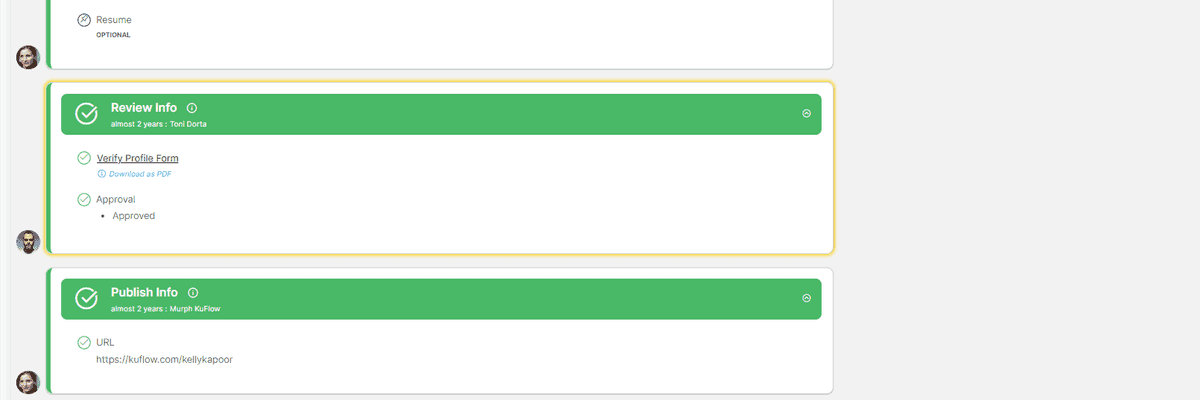New design for workflows: messages
Published 19-09-2024 by KuFlow

Credits: KuFlow
From tasks to messages for a smoother process management experience
In today’s business world, agility and efficiency are key factors for success. Organizations are constantly searching for tools that help them manage their processes more effectively while ensuring a smooth user experience.
At KuFlow, we understand the importance of building platforms that not only optimize workflows but also offer an intuitive and enjoyable experience. This is why we’ve introduced a significant update to our platform: the structure of processes has shifted from being task-based to being organized around messages.
This change represents a major improvement in how users interact with workflows within KuFlow, resulting in more fluid and efficient business process management. But what does this transformation entail, and why is it so important? Let’s dive into the details.
From tasks to messages: a new way to interact with workflows
Until recently, the structure of a process (or workflow) in KuFlow was based on Tasks. Each task represented a step within an organization’s workflow and could be executed by either humans or automated systems.
These tasks constitute the fundamental components of any business process, providing key moments for the collection of information, interaction with external systems, presentation of data to users, among other essential functions for the correct execution of the workflow.
Each task was displayed on a separate screen, allowing users to manage different steps of the process in an orderly fashion but with a certain level of fragmentation in the experience. While this structure was effective, some users might have felt that the workflow became somewhat rigid, with interruptions between tasks, which affected the sense of progress.
With our latest update, we’ve redesigned this experience. Now, instead of isolated tasks, processes are structured as a sequence of messages, much like a chat conversation. Each step of the process—whether performed by a user or an automated system—appears as a message in the interface:

This design change not only enhances the fluidity of the experience but also makes it easier to visualize the sequence of actions, allowing users to better track the process from start to finish.
A more intuitive and seamless interface
The shift towards a message-based structure brings multiple benefits for users. The most obvious is simplicity. By making the user interface resemble a conversation, organizations using KuFlow can follow the development of a process in a more intuitive and natural way. This translates into a clearer sense of continuous progress and less need to switch between screens or contexts.
Instead of viewing the process as a series of isolated tasks, users can see the workflow as a dynamic conversation, where each message represents a step towards the final goal. This not only improves usability but also enhances transparency and understanding of the process itself, as all messages—whether generated by users or systems—are easily accessible and chronologically ordered.
More than just text: messages enriched with data
One of the most powerful aspects of this new structure is that messages are not limited to simple text phrases. Each message can contain associated data, which may come from external APIs or third-party systems. This allows for much richer and more productive interactions within the workflow, as relevant information can be shared and used in real-time within the process.
For example, if a step in the process requires retrieving information from an external database or an enterprise resource planning (ERP) system, the message generated in KuFlow can automatically include the obtained data. This data is not only displayed as part of the message but can also be used to influence subsequent steps in the process, enabling even more sophisticated and efficient automation.
A leap forward in user experience and process management
This change in how processes are structured in KuFlow not only optimizes the user experience but also opens new opportunities for organizations to improve the way they manage their workflows. The ability to structure processes as a sequence of messages makes collaboration between different stakeholders easier, as information is always accessible and naturally organized.
Moreover, this message-based approach encourages a more continuous flow in processes, which can reduce wait times and increase productivity. By enabling more seamless and less fragmented interaction, organizations can gain better visibility into what is happening at each moment and react more quickly to potential bottlenecks or issues.
It’s important to note that while we’ve introduced this new message-based structure, we haven’t removed the ability to create and assign tasks. Tasks are still available in KuFlow, but they are now presented more intuitively, integrated into a friendlier and less transactional interface. This approach allows users to manage their processes more smoothly without losing the ability to assign and complete tasks when needed. We’ve enriched the model to provide a more flexible and natural experience, while retaining all the functionality you’re already familiar with.
Conclusion: an evolution toward a more human experience
At KuFlow, we continue to work on delivering a platform that is not only powerful and flexible but also intuitive and enjoyable to use. With this new message-based structure, we’ve taken an important step toward creating a more human experience, where processes flow in a more natural and continuous way.
By transforming workflow management into something as simple as following a conversation, KuFlow allows organizations to focus on what truly matters: achieving their business goals efficiently, without unnecessary complications.





